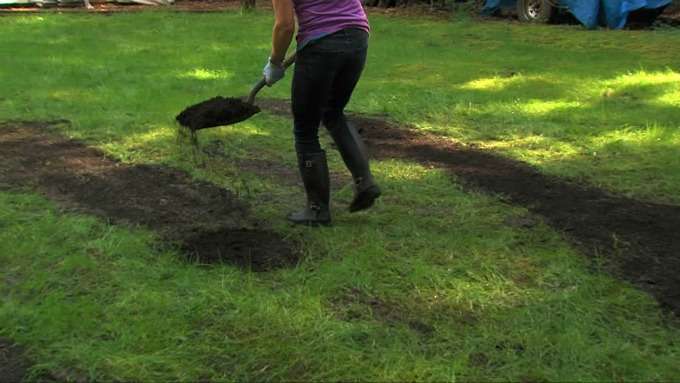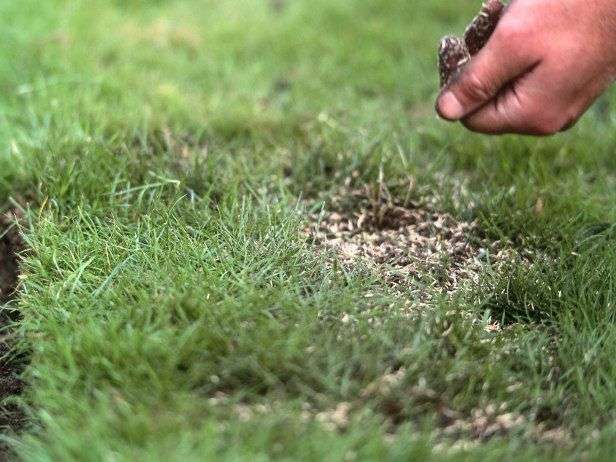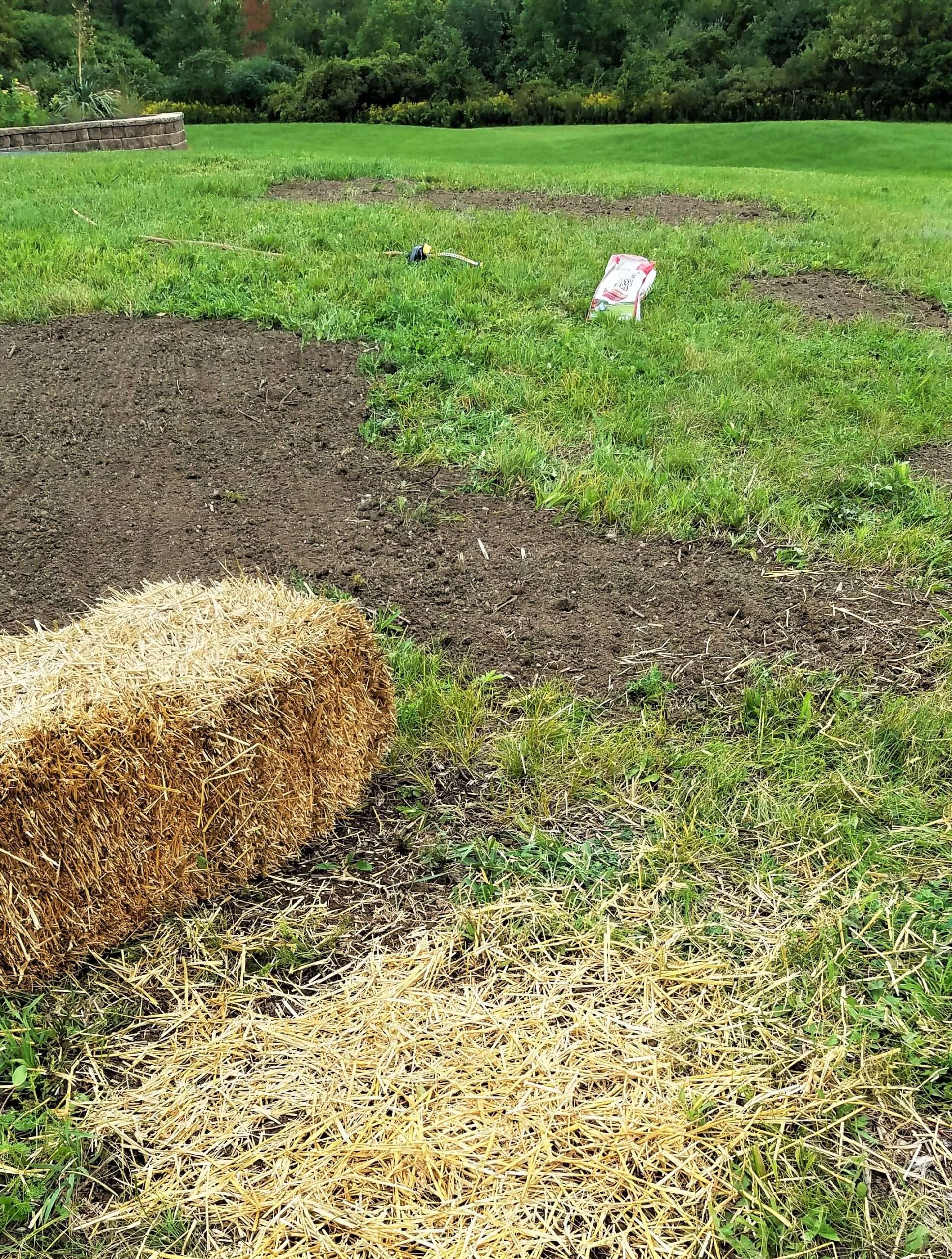What Causes Bare Spots In Lawns
Bare spots in lawn areas can be caused by a number of things, and knowing how to fix patchy grass starts with identifying your lawn issues. Take the time to investigate, and try to get to the bottom of your bare spot mystery before taking the steps necessary to correct the problem. Otherwise, you may continue to repair bare spots without addressing the actual cause.
Bare spots are often the result of:
- Excessive foot traffic
- Chinch bugs and other insects
- Fungal disease
Dont worry if you cant narrow down the exact cause of the bare spots right away. Just paying attention to the location and size before you begin to repair spots can make a huge difference. If the spot returns, then continue to investigate the cause.
What If You Plan To Add A Lot Of Topsoil To Your Bare Patch
If youre adding a fair amount of topsoil, you will be better off seeding in the late Summer or early Fall. The reason for this is that topsoil carries a lot of weed seeds that will sprout prolifically in the Spring and Summer. Keep the area wet for 3-4 weeks to get the grass to sprout and water it a couple times per week until it is fully established.
If The Seed Dries It Dies
Watering your grass regularly after seeding the bare patches is crucial. The trick is to keep the seed moist for the first 2 to 3 weeks until you begin to see seed germinations, a.k.a. grass growth. So, to start, water your lawn for 10 minutes in the morning and 10 minutes at night. This can be done with either a handheld nozzle or a spot sprinkler.
Once the seed has started to grow, we recommend 10 minutes of watering per day or 1-inch of water per week. The way to test how much you are watering is as follows:
-
Place a frisbee upside down on your lawn, water until it fills the frisbee to the halfway point
-
If you practice doing this twice a week, your lawn will receive about an inch of water
Additionally, if there is a heat wave during the time your seed is beginning to germinate, increase the frequency of watering to 3 to 4 times per day. You want the top inch of your soil to stay moist. However, if its raining dont bother watering. If you over water your lawn, you could displace the seed and overload them. After overseeding, you should have moist soil, but not a mud puddle. Consistency and commitment is key! If you follow these instructions diligently, your lawn is sure to return to peak performance.
Recommended Reading: Getting Rid Of Violets In Lawn
What Causes Bare Spots In My Lawn
If you notice Bare Spots in your otherwise lush, green and healthy lawn, they could be the result of excessive foot traffic, poor soil conditions, pet urine, grub infestation, chemical spills, fungal disease, buried rocks, or a variety of other things. Several approaches exist to effectively patch these Bare Spots, however, it’s important to understand and address the underlying cause, so that this same problem doesn’t continue to manifest in your lawn. If you’re uncertain about the catalyst for your Bare Patches, give us a call or submit a question and we can offer some insight.
Lawn Care: How To Repair Bare Grass Patches

As lawns emerge from winter dormancy, it’s exciting to watch them green up. What’s disappointing, though, is discovering that the lush lawn you put to bed late last fall is awakening with brown or bare spots.
The toughest part of dealing with lawn spots is discovering what’s causing them. Learn 10 common reasons for spring lawn spots and what you can do to fix them.
Cause: Dogs
If your dog has used the same area of the lawn all winter long , you may discover brown or bare spots.
Solution: If the grass isn’t dead, flush the area with water . Mow higher in this area until the spot greens up. If the grass is dead, reseed. Create a mulched area in an inconspicuous part of your yard and train your dog to use that area.
Cause: De-icing methods
The salts in de-icing materials can burn grass. Typically this damage appears as a narrow band along a walkway, street or driveway. Damage may also occur where you pile snow from streets or sidewalks.
Solution: Before reseeding, flush the area with water. Let spring rains help with this task. Reseed with salt-tolerant grass varieties. Frequently these grasses are included in mixes intended for boulevard plantings, which are sold in regions where winter requires salt-laden road treatments. Check with independent garden centers for these blends.
Cause: Object left on the lawn
Cause: Snow mold
Solution: Rake Snow Mold spots to separate matted blades. Most often, grass grows out of the disease. If not, reseed.
Cause: Meadow Voles
Cause: Exhaust
Also Check: Killing Speedwell In Lawns
Get The Most Out Of Lawn Patch And Repair Mixes This Spring
We often see dead patches or bare spots as the snow disappears and lawns green up. This can be caused by a number of winter stresses. If patches are greater than a few inches wide, recovery will require the addition of seed or sod. Consider the following when choosing retail-available products or DIY approaches to patching these areas.
Recommended Reading: Cut The Grass Simulator Codes
Solve Existing Lawn Problems
Lawns can be a great addition to any home, but only if they are appropriately taken care of. One common issue with their lawn is that the grass is not thick or healthy-looking. This may be due to several factors, such as problems with the soil, pests or diseases, or incorrect watering habits. To correct this problem and overseed or reseed your lawn, you will need to closely look at what is causing it.
If the grass is thin or patchy, it may be due to a lack of nutrients in the soil. In this case, you can add some organic matter or fertilizer to help improve the quality of the soil. Be sure to follow the directions on the package carefully to not damage your lawn further.
Also Check: Tru Green Lawn Care Prices
How To Overseed A Patchy Lawn
There aremany easy fixes that will help to bring your lawn back to life and keep it lookingits best. Follow our step-by-step guide on how to overseed your lawn –
Removeany dead grass, weeds, or moss by scarifying/raking the area
Rake thearea enough so that the soil is loose and not compact
Sow some seedat our recommended rate of 35g per m2, by using a seed spreader or you hand
Rake theseed in after sowing so that the seed is in amongst the soil
Firm downby foot or by using a roller to improve seed to soil contact
Water thejust-sown seed well
If you arenew to overseeding and this is your first time doing it, you can follow ourmore detailed guide on how to overseed your lawn.
How Do You Fix Patchy Grass
Once you find out what is causing the patchy grass, you can see here how to reseed lawn if you need new grass in patches.
One of the first things you need to be sure of before overseeding lawns is that the soil temperature is around 52 degrees Fahrenheit. Besides this, you need good seed-to-soil contact so that the seed can germinate quickly.
Don’t Miss: All Wheel Drive Push Lawn Mowers
Water Generously At First Less Later
Water the area immediately, and then continue to water lightly three times a day for 7-10 days. When you can see the new grass sprouting, reduce watering to once daily.
Tip: After the new grass emerges, less is more. A good, thorough soaking rather than a quick watering ensures that the water gets down to the root system. This helps roots grow strong and deep for a thick, more drought-resistant lawn.
Spread Your Grass Seed
You need to remember a few key things when spreading grass seed to overseed or reseed your lawn:
- Make sure you are using the correct type of seed for your climate and the specific needs of your lawn.
- Be sure to water the seed properly to germinate and take root.
- Give the new grass enough time to grow before mowing it.
Apply seed at the stated overseeding rates using the appropriate lawn spreader like Scott Elite. To treat big lawns, use drop or broadcast spreaders. Small patches can be seeded by hand. Work in calm air to ensure seed distribution.
Also Check: John Deere Lawn Tractors Lowes
Benefits Of Overseeding Summary
A naturally thick and healthy lawn is the best defense against weeds, so taking care of those bare patches is vital. Not only do you want a healthy lawn, but youre defending your grass against weeds taking up residence in your yard. It cant be emphasized enough your newly seeded grass needs water. Do not neglect your daily watering schedule. Sun and wind can quickly suck up the moisture from the soil. Remember: if it dries, it dies. Your overseeding journey will go well if you follow these simple instructions, continue with regular care and maintenance after the seed has been spread, and treat it with care until the grass has fully germinated in those areas.
Once your lawn begins its return, and you start to notice thick and healthy grass sprouting throughout your front and back yard, be sure to get outside and take advantage of the sun. Invite friends over for a dinner party on your fresh grass, reap the rewards of your labour.
Items Have Been Linked Here For Your Convenience:
Repair Your Patchy Lawn

Even if your lawn is in poor condition, it is possible to achieve a healthy, dark green expanse of perfect lawn by overseeding, or introducing some fresh seed into the sparse or thinning areas.
Your lawn will never be better than the grass seed you plant, so we recommend overseeding with either Black Beauty® Ultra grass seed mixture or Black Beauty® Fall Magic grass seed mixture after Labor Day:
- Black Beauty® Ultra is most similar to what is found on sod farms. The seed mixture contains three grass types for species diversity and these are tall fescue, Kentucky bluegrass and perennial ryegrass. These grasses grow a naturally dark-green and beautiful lawn with excellent heat and drought tolerance. Black Beauty Ultra® grass seed germinates in about 14 days and will improve any lawn it is overseeded into.
- Black Beauty® Fall Magic has been specially formulated for successful fall seeding and contains several grass types, including Black Beauty® tall fescues. It can be used in sun and shade lawn areas on established lawns or to start new lawns from scratch. Black Beauty® Fall Magic repairs summer damage and provides an attractive, thicker, greener lawn, with germination in 10 to 14 days.
Recommended Reading: Level Lawns Atlanta Reviews
A Lush Lawn Can Still Be Prone To Bare Spots We Take A Look At The Causes How To Repair Them And Cover The Bare Spots
You finally have your lawn just how you want it green and lush and thriving. Then, all of a sudden, a bare spot appears. What to do? To find out why bare spots occur, and how to fix them to return your lawn to its splendor, we checked in with Joe Churchill, senior turf specialist with Reinders, Inc. to share his insights and tips.
What Causes Bare Spots
Hard or compacted soil can make it difficult for grass seed to grow because the roots are unable to access the air and soil nutrients they need to grow. Shade from trees, buildings, and other objects can cause thin grass growth, straggly grass, and bare patches. There may be dead spots in the lawn because those areas are not getting enough sunlight. Fertilizers, herbicides, pesticides, and some insect repellants can cause brown spots if spilled. If not applied properly, these products could burn the grass. Lawn diseases and insects like soil surface-feeding chinch bugs and sub-soil feeding white grubs can cause thin, patchy grass. The family dog can also be a culprit for some of the brown spots that appear in our lawns.
Recommended Reading: Nitro Phos Barricade Spreader Settings
Oozing Orange Sap On Birch Tree
In spring, it is a common phenomenon to observe bright orange slimy sap residues on the tree trunks of bleeding trees like birch, ironwood, maples, elms and walnut. In bleeding trees, any unsealed wounds on the tree trunk cause the spring sap to naturally ooze out externally. It is observed that the yellow-bellied sapsuckers are associated for causing spring wounds by drilling horizontal and vertical holes.
The oozing sap is rich in sugar and serves as a growth media for bacteria, fungi and yeast that turns the colorless sap to bright orange in color which catches our attention. Once the wound on the tree trunk is sealed by the trees natural compartmentalization process, the sap will stop flowing and the oozing materials will start to dry out.
Though the orange sap residue may give an unaesthetic appearance, it doesnt affect the trees health.
How To Seed And Repair Bare Spots On Your Lawn
Seeding your lawn is important because, regardless of how much time you spend in your yard, your lawn is bound to thin and brown as it ages. One of the best ways to re-vitalize your lawn is by overseeding. Overseeding repairs the bare spots in your grass, and when your grass is full and healthy, weeds find it harder to grow. As well, a green lawn looks better and feels better. So, weve established the advantage that seeding gives you as a homeowner, now well go over how to repair your lawn and the instructions you should follow thereafter.
Recommended Reading: When Should You Fertilize Your Lawn In Colorado
Time To Overseed Or Reseed Your Lawn
The best time to overseed or reseed your lawn is in the early fall. The soil is still warm from the summer sun, and the days are getting shorter, which means your lawn will have time to establish before winter. However, if you live in a colder climate, you may want to wait until late fall or early winter so that the new seedlings wont suffer from frostbite.
Prepare The Area To Overseed Or Reseed Your Lawn
There are a few key things you can do in preparation for overseeding or reseeding your lawn:
- Remove any debris from the area, including leaves, branches, and stones.
- Rake the area to loosen the soil and create a smooth surface.
- Apply a layer of compost or manure to the area and rake it in.
- If youre overseeding, spread the seed evenly over the area and rake it in. Dig up the entire lawn and remove any old grass or weeds if youre reseeding. Sprinkle the new seed over the place and rake it in well.
- Water the area well until the soil is moistened completely.
- Keep the area wet until the new grass has grown in completely usually about two weeks.
You May Like: How To Kill Wild Violets In Yard
How To Overseed Or Reseed Your Lawn In 10 Easy Steps
In order to avoid a lawn that looks like a barren desert, you need to know how to reseed your lawn. By following these simple steps, you can create a beautiful and healthy lawn that will last for years.
Seeding a lawn is the process of planting new grass seed in an area where the grass is thin or missing. There are two ways to do this: overseeding and reseeding. Overseeding is the best way to fill in small patches of thin or balding grass. Reseeding is done when you want to replace your lawns grass completely.
Overseeding is the technique of seeding an existing lawn. It is often done in the fall when the weather is cool and the days are shorter. The new seed will germinate and grow slowly over the winter so that by the time spring arrives, your lawn will be thicker and fuller.
How To Repair Bare Spots In Your Lawn

- Pin
Bare patches in an otherwise full, healthy lawn may be the result of pet urine, heavy foot traffic, infestations by grubs or other pests, or a variety of other causes. There are several ways to effectively patch these areas, but you also need to consider the causes and correct them if you can. For example, if a bare patch occurs because natural foot traffic continually pounds one area, no fix will be permanent unless you also solve the traffic flow issue. And if the bald spots are caused by a lawn grub problem, new bare patches will crop up as soon as you repair the old onesunless you address the grubs.
There are two easy methods for restoring bald patches in your lawn: reseeding and patching with sod.
Working Time: 20 minutes to 1 hour
Total Time: Two to six weeks
Skill Level: Beginner
Material Cost: $5 to $10
Recommended Reading: Using Peat Moss To Grow Grass
